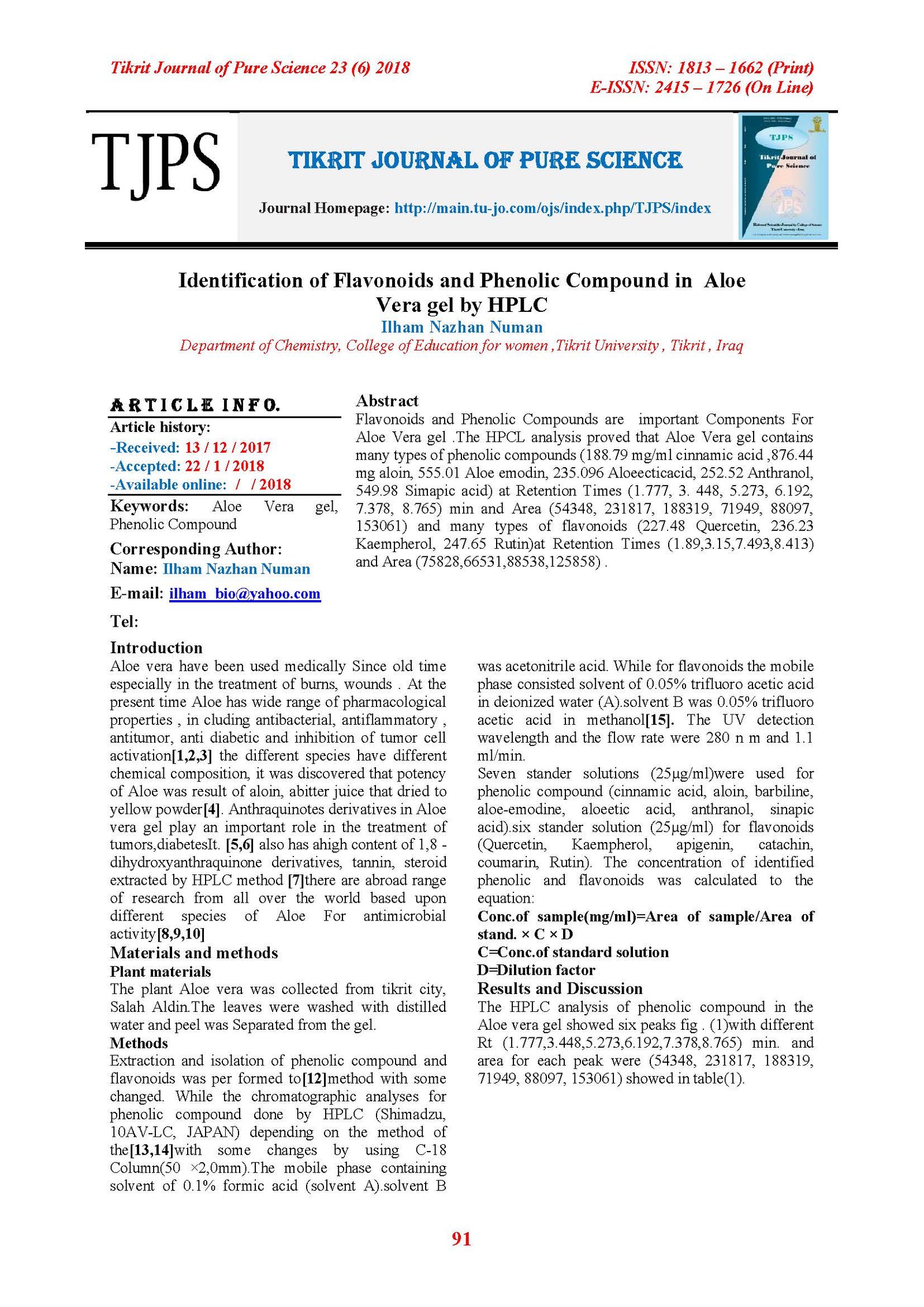Identification of Flavonoids and Phenolic Compound in Aloe Vera gel by HPLC
Main Article Content
Abstract
Flavonoids and Phenolic Compounds are important Components For Aloe Vera gel .The HPCL analysis proved that Aloe Vera gel contains many types of phenolic compounds (188.79 mg/ml cinnamic acid ,876.44 mg aloin, 555.01 Aloe emodin, 235.096 Aloeecticacid, 252.52 Anthranol, 549.98 Simapic acid) at Retention Times (1.777, 3. 448, 5.273, 6.192, 7.378, 8.765) min and Area (54348, 231817, 188319, 71949, 88097, 153061) and many types of flavonoids (227.48 Quercetin, 236.23 Kaempherol, 247.65 Rutin)at Retention Times (1.89,3.15,7.493,8.413) and Area (75828,66531,88538,125858
Article Details

This work is licensed under a Creative Commons Attribution 4.0 International License.
Tikrit Journal of Pure Science is licensed under the Creative Commons Attribution 4.0 International License, which allows users to copy, create extracts, abstracts, and new works from the article, alter and revise the article, and make commercial use of the article (including reuse and/or resale of the article by commercial entities), provided the user gives appropriate credit (with a link to the formal publication through the relevant DOI), provides a link to the license, indicates if changes were made, and the licensor is not represented as endorsing the use made of the work. The authors hold the copyright for their published work on the Tikrit J. Pure Sci. website, while Tikrit J. Pure Sci. is responsible for appreciate citation of their work, which is released under CC-BY-4.0, enabling the unrestricted use, distribution, and reproduction of an article in any medium, provided that the original work is properly cited.
References
1. Alemdar, s.; Agaoglu, S. Investigation of in vitro antimicrobial activity of aloe vera juice. J. animal adv. 2009; 8: 99-102.
2. beppu; H.; koikeg T. and shimpo, k. Radical scavenging effect of Aloe arborescens miller on prevention of pancreatic islet B-Cell. J. enthro pharmacology2003;89:37-45.
3. Amar, s.; Resham, v. Aloe vera: ashort review. J. Indian. 2008;53(4):163-166.
4. karpagam,t; T.; Devaraj, R. Studies on the effieacy of Aloe vera on antimicro bial activity. J. Inter national Res. 2011; 2:1286-1289.
5. Kammoun,; Miladi, S. In vitro study of Aloe vera leaf extracts. lipids in health and disease. 2011;10, 30.
6. khaing, T.A. Evalution of the anti fungal and anti oxidant activity of the leuf Aloevera. In proccedings of world Academy of seience.2011;75:610-612.
7. NEJATZADEH, F. Antibacterial activity and antioxidant capacity of Aloe vera. Organic and Medicinal chemistry letters. 2013;3:1-8.
8. Vidic, D., Taric, E., etal. Determination of total Phenolic content and antioxidant activity of ethanol extracts from aloe spp. Buletin of the chemists and Technologists of Bosnia and Herezegovina. 2014;42: 5-10.
9.kumalaingsih, S.; Wijana, S. Microenencapsulation of Natural antioxidant power from Aloe vera. J. Food Res. 2013;20:285-289.
10. Trishna, D.; Mithun, G. Identification of phenolic constituents and antioxidant activity of aloe barbadensis flower extracts. j. food and Agricultural immunology. 2017; 124:1-12.
11. Lopez, A.; de Tagil, M. Phenolic constitu ents, Antioxidant and preliminary Activity of leaf Aloe vera . Molecules. 203;18:4942-4954.
12. Lucini, L.; pellizzoni, m. phytochemical constituents and in vitro radical scavenging activity of different Aloespecies. food chemistry. 2015;170: 501-507.
13. Ali, K.; et al.in vitroevaluation of antioxidant activity of some plant methanol extracts. Biotechnology and Equipment. 2015;6(6):1184-1189.
14. Bernadl, D.; Pacomel, A. Phyto chemical and antioxidant of roselle. J. Pharmaceutical Res. 2014; 4(5):1454.
15. Suarez, B.; Palacios, N. Liquid chromatography for quantifying poly phenols. J. Chromatography. 2005; 1055:105-110.
16. Ravi, S.; Kabilar, P. Spectroscopy studies on the status of aloin in Aloe vera. J. Experimental scie. 2011;2:10-13.
17. Aroa, L; Miguel, S.; et al. Phenolic Contituents, Antioxidant and preliminary Antimycoplasmic Activities of Leaf Skin and Flowers of aloe vera (L.) Burm. f. (syn. A.barbadensis Mill.) from the canary Islands (Spain). Molecules. 2013;18:4942-4954.
18. Zaira, L.; Gabriela, N.; et al. Antioxidant and Cytotoxicological effects of Aloe vera food supple ment .J. Food Quality. 2017; 2017:10.
